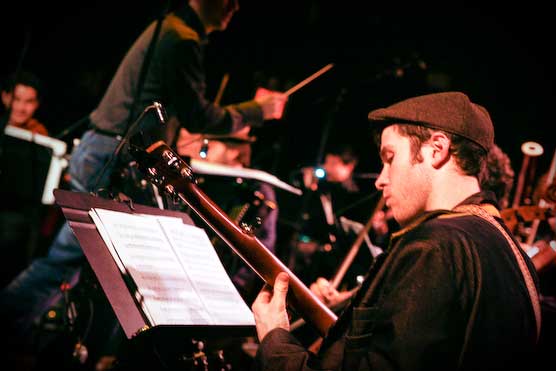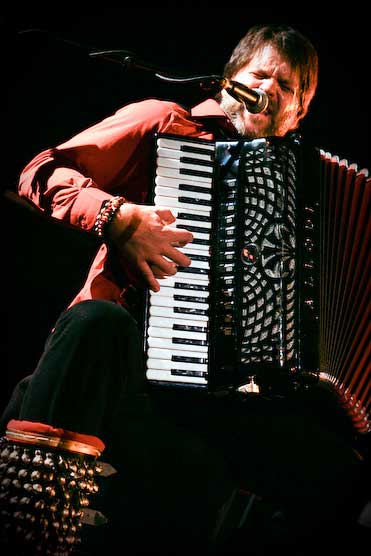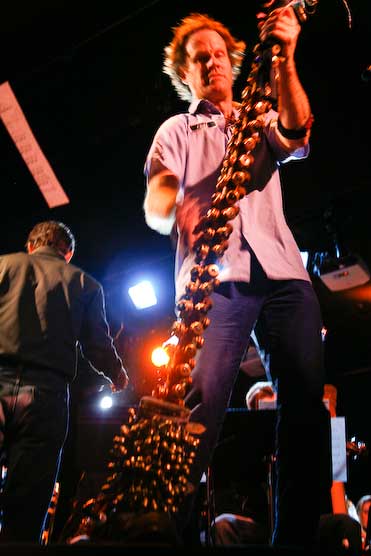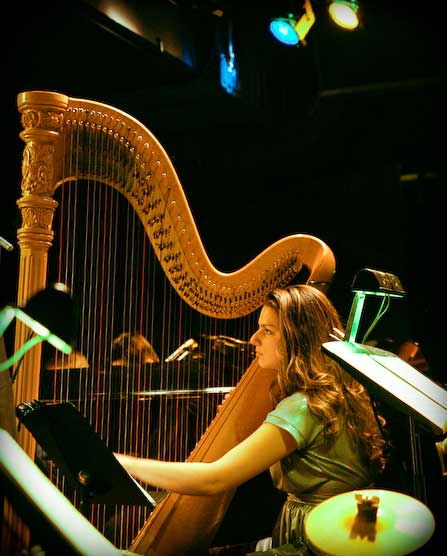Groanbox by DAVID BRUCE
| Instrumentation | fl/pic, cl, ob/cor,bsn,hn,tp,tb,harp,banj,acc,2 perc, str qt, bass | ||||||||||||||
| Duration | c.22 mins | ||||||||||||||
| World Premiere | Metropolis Ensemble + Groanbox Boys 28th Jan 2009, Le Poisson Rouge, NYC | ||||||||||||||
| Commission | Commissioned by the Metropolis Ensemble with major support from the Argosy Foundation | ||||||||||||||
| Composed | Nov 2008- Jan 2009 | ||||||||||||||
| Score | Available | ||||||||||||||
| Recording |
The Groanbox Boys and Metropolis Ensemble, conducted by Andrew Cyr.
| ||||||||||||||
| Video Groanbox Mvt 1: Goat Train Groanbox Mvt 2: Cajun Races Groanbox Mvt 3: Satie's Scooter Groanbox Mvt 4: Redhook Revival Rival | |||||||||||||||
| |||||||||||||||
Photos
| |||||||||||||||
Programme note The following is the program note for the Metropolis Ensemble's concert featuring the premiere performance of Groanbox: "Mr Gershwin, music is music." (Alban Berg, 1928)
We all love to pigeon-hole;
we are defined and often define ourselves as a "classical composer”
or a "folk musician.” But the truth is, as Alban Berg told
a certain young American popular composer, when the latter hesitated
to perform his songs in front of the great Austrian, "Mr. Gershwin,
music is music,” and in reality the vast majority of musicians cross
back and forth over these artificial dividing lines of style several
times a day. No one more so than Michael Ward-Bergeman, accordionist
with the Groanbox Boys, who last year went literally overnight from
foot-stomping with the Boys in a Southern English pub, to joining Yo-Yo
Ma onstage for a new concerto with the Boston Symphony Orchestra.
The great thing about Michael is he is one of the hardest people to
pigeon-hole I know.
I first met Michael on the Dawn Upshaw/Osvaldo Golijov workshops for composers and singers at Carnegie Hall. He was horrified to see me, as nobody had told him we were to share a hotel room during the residency. I barged in and caught him watching a corny old Western film. Pizza boxes and large quantities of accordion equipment were scattered on the floor. Despite, or perhaps because of being flung together at such close quarters, we hit it off, and discussion soon led on to a number of mutual musical interests. Michael introduced me to his self-built instrument, the lagerphone, a percussion instrument made from a large wooden pole, fixed with beer bottle tops (hence the 'lager') along its length and a boot to stomp with at the base. This instrument forms the centre-piece of the Groanbox Boys performance, and his description of it inspired me to build my own, which I then incorporated into the piece I wrote for the workshops, Piosenki. Shortly before this I had come across a program the Metropolis Ensemble were putting together, featuring a piece of Osvaldo Golijov's (my mentor on the Carnegie program), together with a new piece for one of my favourite instruments, the mandolin. The colorful program caught my eye and I fired off an invite to Andrew Cyr, Metropolis Ensemble’s artistic director and conductor, inviting him to the premiere of Piosenki. Andrew came and a second musical and personal friendship was soon flourishing - it was a good first trip to NYC! For the Ensemble’s April 2008 concert, I made an arrangement of Satie's Sports et Divertissements for the group. I was stunned and thrilled by the quality of the musicianship the ensemble brought to my little arrangement. In the intervening year or so, Groanbox Boys concerts had become a regular feature of my life. For me, what makes them special, apart from their high-energy, riotous stage presence, is the sheer quality of their musicianship. Cory has to be one of the finest banjo, guitar and harmonica players I've ever heard and Michael somehow combines bass line, chords, foot-stomping percussion, and an earthy soulful voice, all in perfect synchrony. More recently Paul Clifford has added his own perfectly eccentric and eclectic selection of percussion into the mix, and it now seems hard to imagine them without him. So a voice entered my head: what would happen if we mixed the Groanbox Boys with the amazing players from the Metropolis Ensemble? I mentioned the thought to Andrew and he jumped at the idea. We would create a program inspired by American folk music, which, in that terrible phrase, cross over the boundaries between the classical world and the folk world. It seemed a great idea to ask Michael, who is also a composer (you see what I mean about the pigeon-holes), to write a piece for lagerphone and ensemble, a 'lagerphone concerto' if you will. That is the piece that literally kicks off tonight's concert, the evocatively-titled Kicking up Dust. I am certain Michael's piece will, like a good opera overture, provide a sense of the scale for the evening ahead, and also hints of what is to come. Michael tells me the piece he has written was inspired by the African-American Fife and Drum tradition. Next comes John Adams's Gnarly Buttons. Adams is of course one of America's leading composers, and one of the most performed, but in this piece he draws particularly heavily on American folk music, even featuring a part for banjo. It is an intricate and unusual work that ranges from wild, dance-like figures through to tranquil serenity at the end. Its three movements are, Adams says "based on a 'forgery' or imagined musical model: The Perilous Shore -- A trope on a Protestant shape-note hymn found in a 19th century volume, The Footsteps of Jesus. The melodic line is twisted and embellished from the start, appearing first in monody and eventually providing both micro and macro material for the ensuing musical structures, Hoe-down (Mad Cow) – Normally associated with horses this version of the traditional Western hoe-down takes the perspective of the other animal. Put Your Loving Arms around Me - A simple song, quiet and tender up front, “gnarled and crabbed at the end." Andrew Cyr then asked me to write the piece that would 'bridge the gap' between the Adams piece and The Groanbox Boys performance, a piece which would plunge itself even more thoroughly in the folk tradition than the Adams piece. In truth, of course, the gap is quite small already. Adams famously said that, "Whenever serious art loses track of its roots in the vernacular, then it begins to atrophy," and he, more than most contemporary classical composers, has led the fight to embrace that vernacular within his music. On the other side of the pigeon-holing, a Groanbox Boys track itself is very much a 'composed' work of art. For all the improvisation and free spirit, it is immediately apparent from the sophisticated orchestration and the range of influence their music incorporates that this is music that has a lot of thought behind it. As a composer whose music has long incorporated folk elements, it has been an incredibly exciting challenge to write a piece for these two groups of outstanding musicians. I titled my piece simply Groanbox, (itself an old American term for the accordion), and wrote a piece which is not at all like a traditional 'concerto', but rather a piece in which the two groups merge as one, along with the two styles of music. I suppose it's a sort of imaginary folk-music I'm writing, played by the largest and most virtuoso village band you've ever seen. The four movements of my piece are as follows: Goat Train – I recently heard musicians from the Polish Theatre company Piesn Kozla ('The Song of the Goat' which interestingly is apparently is the origin of the word 'tragedy') play a bagpipe-like instrument which was literally shaped like a goat. This movement mixes bagpipe-like melodies with a banjo-driven, energetic train-ride groove. Goat Train just seemed to make sense as a title. Cajun Races – The accordion features prominently in most Cajun music and for this comically over-exuberant movement I found myself stuck with the surreal image of wheelbarrow race that careers to the brink of collapse. Satie's Scooter – Another slightly surreal influence, the quirky, clunky, 'broken machine' movement of this piece was inspired by a character called Po from the BBC children's television program Teletubbies, who pushes around a somewhat mournful sounding scooter, squeaking and clanking as it goes. The accordion line that emerged made me think of the French composer scooting sadly along. At the center of the piece however, a radiant violin line unexpectedly blooms, before dying back once again. Redhook Revival Rival – Redhook Revival is a song by the Groanbox Boys which has a quite modern sounding funk-groove. I took it as my mission in this movement to out-funk them. I am sure I won't succeed, but I felt it was important to try. The concert will end with a performance from the Groanbox Boys, playing selections from their new album, Gran Bwa, alongside some of their best earlier work including, I hope, Redhook Revival itself - please compare and contrast at leisure. We all hope you have a great evening, and that the concert will confirm to you the simple truth that there are no barriers to break down, there is no dividing line. There is just music. David Bruce 9 Jan 2009 | |||||||||||||||







